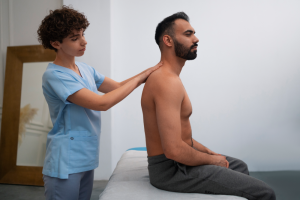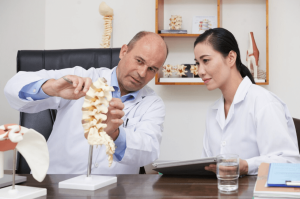From knuckle cracking to neck stretching, joint noise fits seamlessly into the soundtrack of everyday life. These audible releases are known to spark curiosity, comfort, or concern, depending on who you ask.
But why does it feel good to pop joints? Is it truly safe to do so? Let’s break down the science behind the sensation, looking at the potential health effects of joint popping.
What Happens When You Pop a Joint?
The distinct popping sound that occurs when you stretch or twist a joint is typically caused by cavitation — a process where gas bubbles in the synovial fluid rapidly collapse or form due to changes in pressure within the joint capsule. This pressure shift especially occurs in the spine’s facet joints, where gasses can build up and shift due to movement or stretching.
Gas bubbles are composed mainly of nitrogen and carbon dioxide. They’re released when the joint is pulled apart slightly, altering the internal pressure. This sudden change in pressure creates a vacuum effect, which causes the gases to either dissolve or rapidly come out of solution.
Contrary to popular belief, the sound is not caused by bones grinding or colliding. Instead, it’s the result of gas shifting within the synovial fluid, which lubricates and cushions the joint. This is supported by MRI studies showing bubble formation and collapse, not bone movement; further, these imaging studies confirm that joint surfaces remain intact during the process.
After the initial cracking, the joint enters a refractory period in which the gases need time to re-dissolve into the synovial fluid before popping again; this explains why you can’t immediately replicate the sensation in the same knuckle or neck. The temporary delay ensures that the joint structures reset to their baseline state, preventing cavitation until normal pressure levels are restored.
Typically, cracking joints do not indicate damage. The release of pressure and the sound it produces are natural biomechanical reactions — not a sign of wear or injury. In healthy joints, this release is similar to the feeling of stretching a muscle, momentarily increasing mobility without any negative impact.
Why Does Joint Popping Feel Satisfying?
The sensation of relief following joint popping has both physical and psychological roots; this dual effect explains why joint popping can feel physically relieving and emotionally soothing.
Physically, the act of stretching or adjusting a joint relieves pressure and temporarily increases mobility, especially in areas of stiffness or joint pain. There’s evidence that popping a joint can lead to a neurological response that releases endorphins, the body’s natural pain relief agents.
For some — especially habitual knuckle crackers — the action becomes psychologically rewarding, even if no structural change occurs. This, combined with a sense of improved motion or alignment, contributes to the satisfying sensation.
Anecdotally and clinically, many people report a reduction in tension or discomfort after cracking their knuckles or neck. This likely stems from the release of joint pressure and a short-term improvement in mobility. Some individuals feel as if the joint “resets” itself, particularly in the spine or neck, contributing the feeling of improved flexibility and posture.
While the relief may be temporary, for most people, it’s a normal and harmless response that reflects how the body adapts to small imbalances and tension.
Is It Bad to Pop Your Joints?
Occasional joint popping is considered harmless for most people. However, habitual knuckle crackers or those who frequently crack their neck and spine may face risks over time.
If popping joints is accompanied by pain, swelling, or a reduction in movement, it can indicate underlying issues. In some cases, this could be an early sign of knee pain, tendon irritation, or other conditions that require clinical evaluation. Self-manipulation in these cases can make a bad situation worse, with increased inflammation, further misalignment, or even aggravation of an existing injury.
While casual knuckle cracking doesn’t pose significant danger, repetitive or forceful manipulation can. Chronic cracking can overstretch the supporting ligaments around a joint, potentially leading to reduced stability.
Joint instability may increase the likelihood of injury and cause long-term discomfort. Repetitive popping in sensitive areas like the neck can also aggravate nerves. Tingling, numbness, or radiating discomfort may follow, particularly if spinal alignment is involved.
One widespread myth is that cracking knuckles causes arthritis. However, clinical studies have found no correlation between knuckle cracking and the development of arthritis. The noise alone does not signal damage or degenerative change.
Ultimately, the context is crucial — occasional popping is fine, but when paired with discomfort or dysfunction, it’s essential to seek a professional evaluation.
When Should You See a Chiropractor Instead?
If joint popping is accompanied by chronic pain, limited mobility, or neurological symptoms, it’s time to consult a chiropractor. Professional evaluation can prevent further damage and provide a tailored recovery plan. Chiropractic techniques are designed to safely restore joint function and alignment, with practitioners performing precise, diagnostic-based adjustments.
Unlike self-popping, which lacks control or anatomical targeting, chiropractic care addresses root causes such as spinal misalignment or muscular imbalance. Treatment plans include options like corrective care, decompression therapy, or soft wave therapy to optimize recovery, in addition to physical therapy.
Over time, the positive outcomes of chiropractic care are plentiful: improved joint mobility, reduced pain, and enhanced quality of life, to name just a few. Learn more about chiropractic solutions from Evolve Chiropractic.





